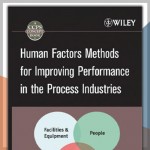Books
The HPOG Steering Committee has identified a number of publications on the subject of Human Performance as suitably aligned to the HPOG approach.
These books can be purchased in various formats from the relevant suppliers via the links below.
Human Factors in the Chemical and Process Industries by Janette Edmonds
 Human Factors in the Chemical and Process Industries: Making it Work in Practice is a comprehensive overview of human factors within this sector, focusing on the practical application. It has been written by acknowledged industry experts from the Keil Centre, which is a leading practice of chartered ergonomics and human factors specialists, chartered safety specialists, registered occupational psychologists, and registered clinical psychologists. It can be purchased here.
Human Factors in the Chemical and Process Industries: Making it Work in Practice is a comprehensive overview of human factors within this sector, focusing on the practical application. It has been written by acknowledged industry experts from the Keil Centre, which is a leading practice of chartered ergonomics and human factors specialists, chartered safety specialists, registered occupational psychologists, and registered clinical psychologists. It can be purchased here.
Handbook of Human Factors and Ergonomics by Gavriel Salvendy
 As with the earlier editions, the main purpose of this handbook is to serve the needs of the human factors and ergonomics researchers, practitioners, and graduate students. Each chapter has a strong theory and scientific base, but is heavily focused on real world applications. As such, a significant number of case studies, examples, figures, and tables are included to aid in the understanding and application of the material covered. It can be purchased here.
As with the earlier editions, the main purpose of this handbook is to serve the needs of the human factors and ergonomics researchers, practitioners, and graduate students. Each chapter has a strong theory and scientific base, but is heavily focused on real world applications. As such, a significant number of case studies, examples, figures, and tables are included to aid in the understanding and application of the material covered. It can be purchased here.
Human Factors Engineering and Ergonomics by Stephen J. Guastello
 Human Factors Engineering and Ergonomics: A Systems Approach is has now been updated to Second Edition. Although still true to its original focus on the person-machine interface, the field of human factors psychology (ergonomics) has expanded to include stress research, accident analysis and prevention, and nonlinear dynamical systems theory (how systems change over time), human group dynamics, and environmental psychology. This reflects the new development. It can be purchased here.
Human Factors Engineering and Ergonomics: A Systems Approach is has now been updated to Second Edition. Although still true to its original focus on the person-machine interface, the field of human factors psychology (ergonomics) has expanded to include stress research, accident analysis and prevention, and nonlinear dynamical systems theory (how systems change over time), human group dynamics, and environmental psychology. This reflects the new development. It can be purchased here.
Ergonomic Solutions for the Process Industries by Dennis A. Attwood, Joseph M. Deeb, Mary E. Danz-Reece
 Work-related injuries, such as back injuries and carpal tunnel syndrome, are the most prevalent, most EXPENSIVE, and most preventable workplace injuries, accounting for more than 647,000 lost days of work annually (according to OSHA estimates). Such injuries, and many others, can be prevented in your facility by establishing an ergonomic design. This book shows you how to apply simple Ergonomic tools and procedures in your plant. It can be purchased here.
Work-related injuries, such as back injuries and carpal tunnel syndrome, are the most prevalent, most EXPENSIVE, and most preventable workplace injuries, accounting for more than 647,000 lost days of work annually (according to OSHA estimates). Such injuries, and many others, can be prevented in your facility by establishing an ergonomic design. This book shows you how to apply simple Ergonomic tools and procedures in your plant. It can be purchased here.
Introduction to Human Factors and Ergonomics by Robert Bridger
 The new edition places the subject matter into a system context using a human-machine model to structure the chapters and a knowledge application model to structure the organisation of material in each chapter. Includes over 200 exercises and essays. An Instructor’s Manual, A Guide to Tutorials and Seminars and and over 500 powerpoint slides are available for academic users from the publisher. All chapters contain ‘HFE Workshop’ sections with practical guidance and worked examples. It can be purchased here.
The new edition places the subject matter into a system context using a human-machine model to structure the chapters and a knowledge application model to structure the organisation of material in each chapter. Includes over 200 exercises and essays. An Instructor’s Manual, A Guide to Tutorials and Seminars and and over 500 powerpoint slides are available for academic users from the publisher. All chapters contain ‘HFE Workshop’ sections with practical guidance and worked examples. It can be purchased here.
Human Factors Methods for Improving Performance in the Process Industries by CCPS (Center for Chemical Process Safety)
 Human Factors Methods for Improving Performance in the Process Industries provides guidance for managers and plant engineering staff on specific, practical techniques and tools for addressing forty different human factors issues impacting process safety. Human factors incidents can result in injury and death, damage to the environment, fines, and business losses due to ruined batches, off-spec products, unplanned shutdowns, and other adverse effects. It can be purchased here.
Human Factors Methods for Improving Performance in the Process Industries provides guidance for managers and plant engineering staff on specific, practical techniques and tools for addressing forty different human factors issues impacting process safety. Human factors incidents can result in injury and death, damage to the environment, fines, and business losses due to ruined batches, off-spec products, unplanned shutdowns, and other adverse effects. It can be purchased here.
An Introduction to Human Factors Engineering by Christopher D. Wickens, John Lee, Sallie Gordon-Becker, Yili Liu
 Offering a somewhat more psychological perspective than other human factors books on the market, this text describes the capabilities and limitations of the human operator--both physical and mental--and how these should be used to guide the design of systems with which people interact. General principles of human-system interaction and design are presented, and included are specific examples of successful and unsuccessful interactions. It can be purchased here.
Offering a somewhat more psychological perspective than other human factors books on the market, this text describes the capabilities and limitations of the human operator--both physical and mental--and how these should be used to guide the design of systems with which people interact. General principles of human-system interaction and design are presented, and included are specific examples of successful and unsuccessful interactions. It can be purchased here.



